|
Parent
| |
History of game concepts
Warning: all information here is unverified and not to be used for
scientific research or publication!!!! I did not do extensive research on this
subject, but i thought i need to mention some history. Please refer to the
origanl links for better information.Information on this page is far from
complete.
I HIGHLY RECOMMEND
JAMES MASTERS SITE FOR HISTORY DETAILS ON BOARD GAMES (just click here)
I guess these pages are not complete without some history. As mentioned above,
please check google and other pages mentioned below for more accurate
information.
Some nice links about history of games are:
Gaming appears to take off during the 20th century. Well, that's not true I
guess, what is true though, is that media / production / distribution channels/
marketing made more easier to distribute games easier during the last century.
What I mean is, suppose a 5th century guy would have designed THE ULTIMATE GAME,
if he would have sold off a 100 copies he would be top, as writing / marketing /
world-wide distribution were not yet invented. However, some great
concepts were invented, that carried for 1000's of years:
 | dice games: gambling based on dices have been around for thousands of
years |
 | card games, based on the ancient Mah Jong game, have been around for
thousands of years |
 | strategy games, based on the ancient GO games, have around for hundreds to
thousands of years of history. |
But games really took off when civilizations became rich and educated and
more efficient production/distribution channels became available (early 1900's).
Nowaday, if you take a close game at game concept, you see that boardbames
always carry some of those ancient concepts.
Just to give you a birdsview, here are some highlights of history of
boardgaming and their impact...
History table
[as mentioned above, info has not been verified. I HIGHLY
RECOMMEND
http://www.tradgames.org.uk FOR DETAILED HISTORY].
| 3300BC |
The one board game
that was found and dated 'oldest' is called
Senet (Egypt, 3300BC). If you
look at the board and rulings, you will find that this game is the
mother of many many boardgames today. |
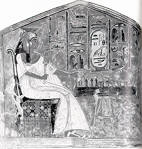 |
|
3000BC |
Marbles and stuff is dated 3000BC.
In addition, a board game called Mehen is found in Egypt and is dated 3000BC. If
you look close you see a very familiar boardgame-layout... |
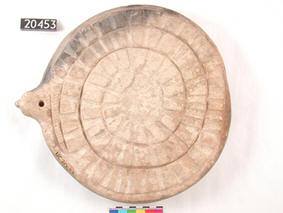 |
| 2600BC |
A game called "Royal
Game of Ur" was found in 1920 near Iraq. Both Senet and Royal game of Ur are
considered to be the predecessors of Back Gammon. |
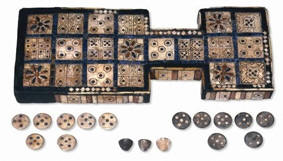 |
|
2200BC |
First mentioning of
Wei-Ch'i, predecessor of Go. Surprisingly GO as we know it today is dated 200BC (though my other other sources it should be
older, but then again, 200BC is pretty old too). With all respect to all other
games, i really believe this the mother of all strategy games. The rules of this games are extreme easy,
the goal is obvious, but nevertheless the game is not to master. Even in
comparance to chess, there are no good Go computer games around that i'm aware of.
This game is known as an allmost perfect game. |
 |
| 2000BC |
Mah Jong is considered to be some kind of invented around this
time. As with all old games, it evoluted over the centuries, so the first
versions were more less card games. Mah Jong as we know it today was created
around 1800. It was however not until the 1920's before this game came to Europe.
Major reason why there is only little known about this game is that this
game was player in the upper ranks of chinese society and they kept this
game to themselves.
It should be
noted the year 2000BC is highly disputable, 1000 AD seems to be more
accurate (that's only 3000 years difference, but who cares) |
|
| 1400BC |
Tic Tac Toe and alike games, Egypt (1400 BC) and
China (500BC). |
 |
| 1500BC |
The
oldest dices were found dated 1500BC in Egypt. Dices were made out of bone and
ivory. Interesting fact: the first 'loaded' dice were found in Pompeii. As a
matter of facts, dices were to be used for gambling and gambling for houses,
wifes, etc. was quite common in the early years of civilization. It should be
noted that randomizing in games was already used in the game Senet, but
by other means. |
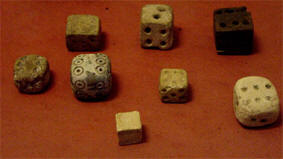 |
| 1400BC |
First mentioning of
Mancala. Mancala is still a very popular game, esp. in Africa. The main
reason maybe that you can the game in any circumstances, you just needs some
holes and some stones. Mancala is played in many variations, most obvious are
two, three and four rows versions of Mancala. |
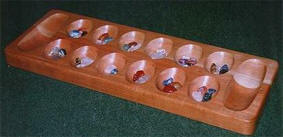 |
| 600BC |
Alquerque,
ancestor of Draughts traced in Egypt |
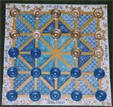 |
| 400AD |
Fist sithting of
Tafl, Denmark. |
|
| 400AD |
First sightings of
Parcheesi. |
|
|
400AD |
Hnefatafl
("King's
Table") game set with "bone" game pieces was inspired by a surviving English bone game
piece found in Woodperry, Oxfordshire. These games were played by Norse cultures
as early as 400 A.D.and were imported by the Vikings to Iceland, Britain,
Ireland, and Wales. They seem to have been the primary strategy games in
Northern Europe until the introduction of Chess. Unlike Chess, or Checkers which
are fought by armies from opposite sides of the board, Tafl games involve a
single king and his defenders in the center of the board surrounded by an army
of attackers twice their number. |
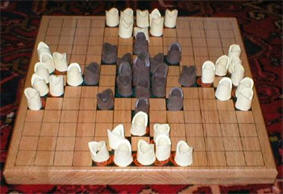 |
| 550AD |
Shaturange, the oldest form of
Chess was mentioned. Over the centuries,
chess evolved in a may ways in many countries (games with dice, played as a
gambling game, forbidden / unforbidden in many countries, etc.). Via Inda,
China, Japan and other Eastern countries it arrived in 1000AD in Europe (first
mentioning in Europe). |
|
| 700 |
Chess ancestors arive in Europe |
|
| 1120 |
First appearence of
Domino.
Since Domino is considered to be the mother of Mah Jong it's highly
unlike that Mah Jong was played before that time. |
|
| 1130 |
First mentioning of Checkers / Draughts in France |
|
|
1400 |
Playing cards were introduced in
Europe by Arabs. Interesting point: for making cards, the need for printing is
required (Gutenberg, 1440). After some experiments over the centuries, the
french suit system (clubs, harts, daimonds and spades) was adopted. Interesting
fact (and copied many times in the 2000 years) was that the prints on the cards
were used for all kind of prints, like satire, heraldery, education, etc.
Reminds me of the many prints currenctly around of for instance Monopoly, Risk,
etc. Interesting side info: evolution of
Tarot was fist mentioned
around 1450. |
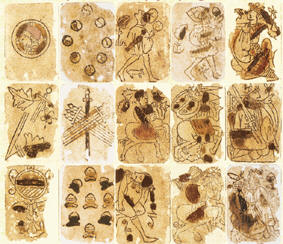 |
| 1850 |
First
reference of Poker was 1834 |
|
| 1900 |
First commercial introduction of Snakes & Ladders |
|
Some Classic games
Just a grab bag of some publications of modern classic games, to give you an
idea of the evolution:
1935: A year to notice, the year that Monopoly was published by
1948: Scrabble was published
1949: Clue was published1956: Yathzee was published
1959: The mother of modern board strategy games was published: Risk.
1960: "Game of Life" was published
1965: Operation / Dr. Bibber (NL) was published
1966: Twister was published
1967: Battleship was published
1982: Trivial Pursuit was published
1986: Jenga was published
1990: Taboo was published. This game was one of the first worldwide published
'adult' games.
198x: Warhammer (Games Workshop) was published
1993: Magic The Gathering, Alpha version was published
199x: The 'German' games become popular
|